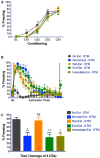Retrieval and Reconsolidation Accounts of Fear Extinction
- PMID: 27242459
- PMCID: PMC4860411
- DOI: 10.3389/fnbeh.2016.00089
Retrieval and Reconsolidation Accounts of Fear Extinction
Abstract
Extinction is the primary mode for the treatment of anxiety disorders. However, extinction memories are prone to relapse. For example, fear is likely to return when a prolonged time period intervenes between extinction and a subsequent encounter with the fear-provoking stimulus (spontaneous recovery). Therefore there is considerable interest in the development of procedures that strengthen extinction and to prevent such recovery of fear. We contrasted two procedures in rats that have been reported to cause such deepened extinction. One where extinction begins before the initial consolidation of fear memory begins (immediate extinction) and another where extinction begins after a brief exposure to the consolidated fear stimulus. The latter is thought to open a period of memory vulnerability similar to that which occurs during initial consolidation (reconsolidation update). We also included a standard extinction treatment and a control procedure that reversed the brief exposure and extinction phases. Spontaneous recovery was only found with the standard extinction treatment. In a separate experiment we tested fear shortly after extinction (i.e., within 6 h). All extinction procedures, except reconsolidation update reduced fear at this short-term test. The findings suggest that strengthened extinction can result from alteration in both retrieval and consolidation processes.
Keywords: anxiety disorders; consolidation; extinction; fear; memory; reconsolidation.
Figures





References
Grants and funding
LinkOut - more resources
Full Text Sources
Other Literature Sources

